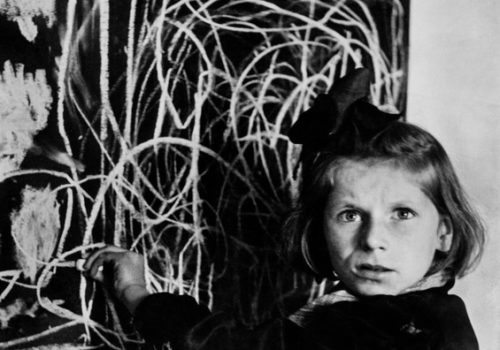On March 10, 1948, Chim(David Seymour) received a telegram from John Grierson, then deputy director of the newly founded UNICEF. Chim – one of the four cofounders of Magnum Photos – was assigned as a “special consultant” to photograph the condition of European children who survived World War II, and to show UNICEF’s action as it provided 13,000,000 children with bare necessities such as powdered milk, soup and shoes, as well as vaccinations against tuberculosis and other diseases.
The assignment soon became a labor of love. Instead of his usual $100 a day, Chim accepted $2,600 for a job that would end up taking him over six months, bringing him in five countries (Austria, Greece, Hungary, Italy and Poland). Not only did he shoot 257 rolls of film – but he went well beyond illustrating UNICEF’s work and succeeded in creating a deeper, broader portrait of the children living through postwar Europe.
They were the most vulnerable victims of the conflict that had raged for six years. Many of them had known nothing in their lives but war. They had spent their first years in underground shelters, bombed streets, ghettos on fire, refugee trains, and concentration camps. They had grown up in a world of fear.
This show focuses especially on the work that Chim did in Hungary and Poland (40 images taken in Hungary and ten in Poland). I have gone back to Chim’s contact sheets and found a good number of images that had never been printed before.
In Hungary, Chim focused especially on social experiments involving children and teenagers. In a high school in Szeged, the teachers who had no lab equipment for their physics and chemistry class devised substitutes for containers such as old light bulbs, empty inkbottles or old cans. On a homemade scale weights are made from pieces of wire, and bottles are used for Bunsen burners.
The town of Hajduhadhawz was the seat of a remarkable experiment in autonomy: 350 boys and girls, orphans, vagabonds or delinquent, were trying to live in a self-sufficient way in a camp they considered home. They elected their own government, grew their own food and printed their own newspaper. Chim photographed the intensity of concentration on the children’s faces: these children are aged beyond their years. They never had a real childhood, and they are intent on making up for the years they have lost.
In Poland, Chim often photographed orphaned Jewish children. In Warsaw, he found out that at the edge of the Jewish ghetto, a high school was still standing. He followed the students as they walked the path among the ruins. In a home for disturbed children in Warsaw, he made his famous image of Tereska: when asked to draw her home, all she can manage is an inchoate scrawl, an expression of her deep trauma. In Otwock, near Warsaw, Chim photographed at Dom Diecka, an orphanage that had taken over the building of the Pensjonat Zacheta, owned by Chim’s aunt and where he had spent his summers as a child. He also photographed at the Zofiowka Sanatorium, a hospital for tubercular diseases – dynamic images of children exercising taken from above, in a Bauhaus-like style.
With his photographs, Chim may have been hoping to express the children’s plea, and raise the public’s consciousness. It is as if he was attempting to make himself whole, as well as the children: he had recently learnt that his own parents had been killed by the Nazis.
This trip was to be Chim’s last to Eastern Europe and the war’s territory.
The problems Chim pointed out in 1948 are still acute. Today, children are still the main casualties of war – maimed, orphaned, and homeless all over the planet, and in even larger numbers than in his time. Chim’s work is a sobering reminder of the plight of the most vulnerable. As his friend Henri Cartier-Bresson said: “At the time, we did not talk about photography: we talked about the world.”
The photographs are Chim’s family album. This spiritual family will remain his only one: the man who loved children would never have any of his own.
Carole Naggar
Chim’s Children of War
October 14-30, 2016
Deak 17 Gallery
Deak Ter#17
Budapest, Hungary
http://www.deak17galeria.hu/en
















